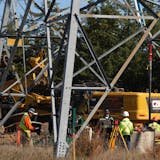Three times Devon ran toward the precipice, and three times he stopped inches short of the 14-foot drop into a jungle swimming hole. After each rush to the edge, he stood motionless, his face half grim determination and half acrophobic fear. As much as his brain wanted him to make the plunge, his body did not.
Along with the others in a group of adventurers on the Yucatán Peninsula, I had already made the leap. Now, we treaded water in the warm, dark cenote, calling Devon's name and offering encouragement. The internal conflict still writ large on his face, Devon swallowed hard, walked forward, paused for what seemed like minutes and finally stepped over the edge.
The easternmost projection of the Yucatán Peninsula is mostly a dense tropical jungle, but it's a jungle unlike any other on Earth. This part of Mexico, a state with the musical-sounding name of Quintana Roo, is commonly known as the Riviera Maya — a sprawling waterfront tourist development of huge hotels and sandy beaches. But a bit inland from those beaches is the Ring of Cenotes, a mostly undeveloped watery paradise where adventurous travelers can walk in the footsteps of ancient Mayans.
In these cenotes (pronounced si-NO-tays), the ancient Mayans communed with their gods. Modern visitors also find this to be a mystical and compelling place. Swimming in a cenote feels like floating back to a time before cars or buildings or mobile phones. This is a place where the modern, built-up world is invisible, where zapote, ceiba and ficus trees loom, great masses of thick hanging vines sway, and fish dart through clear water. Large groups of raccoon-like coatis roam the forest clearings, iguanas sun themselves on rocky ledges, and eagles and hawks ride the thermals in sweeping arcs.
Sixty-five million years ago, an asteroid 6 miles wide smashed into the peninsula. The resulting impact crater stretched for nearly 100 miles. The violence done to the planet was so great that it altered the Earth's climate, resulting in a mass extinction of three-quarters of its plant and animal species. Chicxulub, as geologists now call the extraterrestrial rock, ended the long reign of the dinosaurs.
That was a bad deal for the monster reptiles, but it eventually became a boon for modern-day vacationers. When Chicxulub hit, it fractured the rock beneath the Yucatán Peninsula, turning it into a water-filled subterranean paradise. When it rains, water drips through the shattered stone into a vast network of mostly underground rivers and lakes. Over time, the rock above these rivers has collapsed in some places, exposing the water. Such areas, sacred to the ancient Mayans, are called cenotes, a Mayan word roughly equivalent to sinkhole in English. But while the word sinkhole conjures up something muddy and dangerous, cenotes are clear, verdant and delightful.
Mayan adventures
Along with Devon and 11 others, I visited the cenotes on a tour with Experiencias Xcarat. We spent our day at four cenotes, exploring each in a different way.
Just getting to the remote jungle cenotes is an adventure. While there are about 8,000 cenotes in the area, most are accessible only by roads so pitted and rutted they look like they've been used by the air force for strafing practice. But our driver knows the roads and made good time, although he sometimes stopped to move sleeping dogs from the traffic lane before rattling on.


